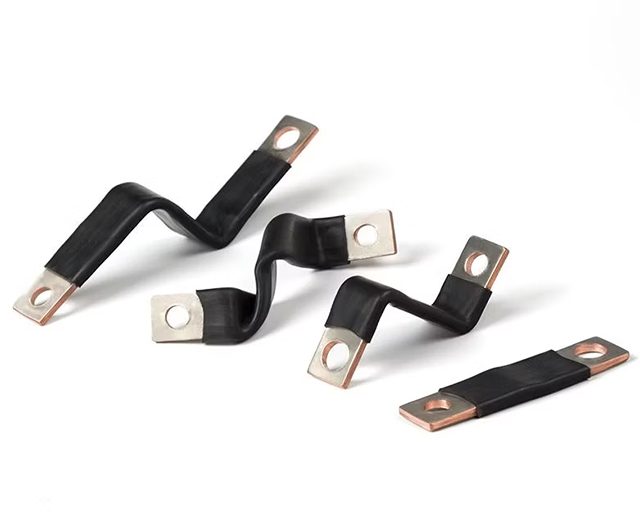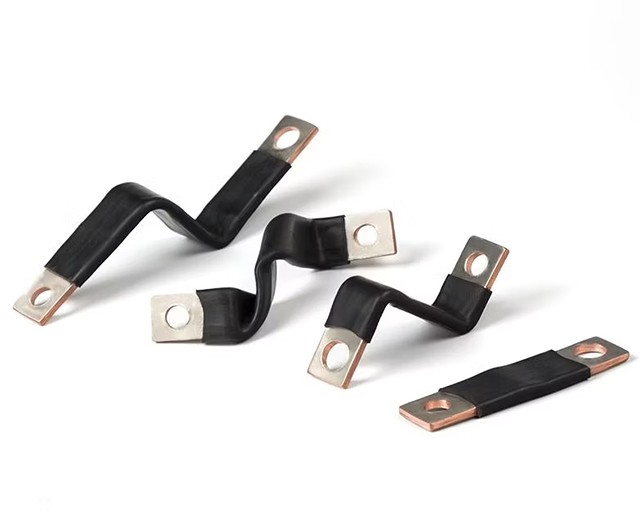

Busbar Flexible, also known as Flexible Copper Busbar, is a high-conductivity laminated conductor designed to deliver power in environments where vibration, movement, and thermal expansion are critical. Unlike traditional rigid Copper Busbars, Insulated Flexible Copper Bars offer superior mechanical adaptability, making them ideal for next-generation electrical systems across EVs, renewable energy, data centers, and industrial automation.
These Flexible Busbars are made by laminating layers of high-purity copper or aluminum—often tinned or silver-plated—and insulating them with heat-resistant, flame-retardant materials such as PVC, PET, or silicone. They offer not only exceptional current carrying capacity (up to 10,000A), but also outstanding resistance to vibration and fatigue—a major advantage in mobile or high-stress environments.

| Property | Typical Value | Remarks |
|---|---|---|
| Current Rating | 200 – 5000A (Custom up to 10,000A) | Optimized for dynamic and compact installations |
| Voltage Rating | Up to 600V AC/DC (Standard), 35kV (Custom) | Meets UL, IEC standards |
| Flexing Life | >10,000 bending cycles | 90° deflection capability |
| Electrical Resistance | 0.5 – 2.5 μΩ/m | Low-loss design for high-efficiency applications |
| Inductance | 0.1 – 0.5 μH/m | 30–50% lower than equivalent cables |
| Operating Temperature | -40°C to +125°C (up to +200°C optional) | Suitable for harsh environmental conditions |
| Bending Radius | Typically 5–10× thickness | Easy to integrate into tight spaces |
| Tensile Strength | 200 – 400 N/mm² (copper) | Supports dynamic load & vibration |
Flexible Braided Copper Busbar – Made from woven copper wires, ideal for vibration-sensitive and grounding applications.
Insulated Flexible Busbar – Covered with durable PVC or PET, suitable for compact switchgear and safe touch-proof applications.
Flexible Busbar for EV Battery Pack – Designed with high-voltage, high-current tolerance and compact layering for electric vehicles and energy storage systems.
Custom Flexible Laminated Copper Bars – Available in bespoke shapes, hole patterns, and multi-layer insulation.
Used in robotic arms, CNC machines, and automated gantry systems where mechanical movement occurs.
Flexible busbars absorb vibration and minimize joint fatigue in motor control cabinets and switchboards.
Connectors between solar trackers and inverters.
Compact Flexible Busbar for EV Battery Pack or battery storage modules to handle high DC currents (800V/1500V systems).
Withstands temperature fluctuations and vibration from wind turbines.
Integration in EV and hybrid electric vehicle battery packs (including solid-state systems).
Railway and metro traction applications—Flexible Braided Copper Busbar ensures EMI control and low-resistance current delivery.
Used in modular data centers for hot-swappable PDUs and blade server racks.
Flexible busbars reduce installation footprint by up to 50% while maintaining high current capacity (up to 5000A).
Inspect laminated conductor surfaces quarterly for discoloration or pitting.
Flex at insulation joints (5–10mm range) biannually to check for cracks or degradation.
Verify terminal torque (typically 20–50 Nm) annually using calibrated torque tools.
Conduct infrared thermal scans to detect abnormal heat rise (>10°C over baseline).
Clean contact areas using 99% isopropyl alcohol; avoid abrasive materials.
Use dielectric grease on sliding or dynamic contact surfaces (ASTM D4950 Type II compliant).
Store coils in climate-controlled environments: 15–35°C and 40–60% RH.
Avoid coil diameters less than 20× thickness to maintain structural integrity.
As a trusted Flexible Copper Busbar and Insulated Flexible Copper Bars supplier, we offer:
OEM/ODM manufacturing with precise CNC punching and laser-cutting capabilities
RoHS/REACH compliant flame-retardant insulation
Global support for EV, solar, rail, and data center clients
Quick prototyping and production runs from 50A to 10,000A
Q1: What is a Flexible Busbar?
A1: A flexible busbar is a laminated conductor made of multiple layers of thin copper strips or braided copper, encapsulated in insulation, designed to carry high current while allowing for flexibility and vibration resistance in compact electrical systems.
Q2: What are the benefits of using flexible busbars?
A2: Flexible busbars reduce system volume, improve current distribution, minimize inductance, and are resistant to vibration and thermal expansion. They also simplify installation and improve durability.
Q3: What materials are typically used in flexible busbars?
A3: The most common conductor material is electrolytic copper (ETP or OFC), and the insulation materials include PVC, EPDM, silicone, or polyimide, depending on the temperature and voltage requirements.
Q4: In which applications are flexible busbars commonly used?
A4: They are widely used in EV battery packs, power inverters, switchgear, UPS systems, renewable energy systems, and industrial control panels.
Q5: What is the current rating of flexible busbars?
A5: The current rating depends on the cross-sectional area, material type, and insulation. Typical flexible copper busbars can carry between 100A to over 3000A.
Q6: Can flexible busbars be customized?
A6: Yes, they can be customized in terms of length, width, thickness, hole size, insulation type, terminal shapes, and layer configuration to suit specific system requirements.
Q7: How are flexible busbars different from solid busbars?
A7: Unlike rigid solid copper busbars, flexible busbars are designed to bend and flex, allowing them to absorb vibration, accommodate thermal expansion, and be installed in tighter spaces.